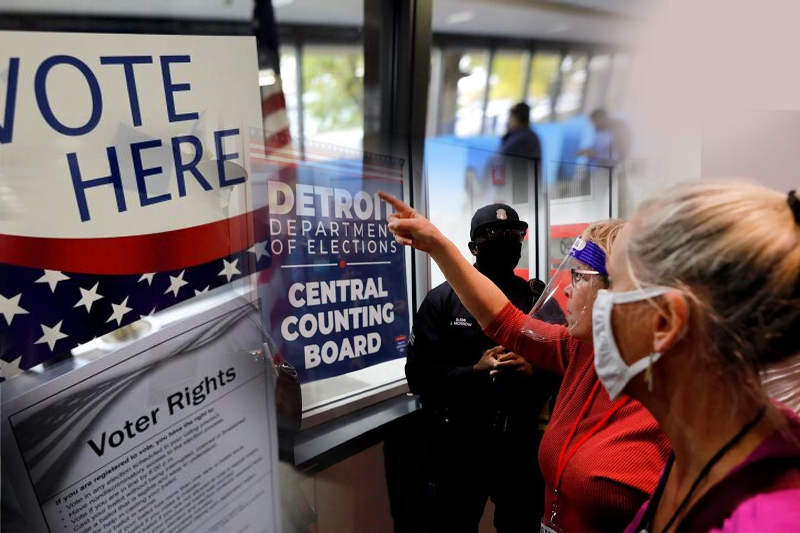
Election workers lament lack of federal security expenditures before midterms
US – Less than two weeks before the midterm elections, millions of government money might have been used to secure election workers and improve the physical security of their offices, but in a classic case of bureaucratic red tape, the majority of these funds remain unused.
The missed financing opportunity comes at a time when election officials across the nation have been subjected to an unprecedented wave of violent threats based on voting procedure conspiracy theories. Now, things such as increased lighting and security guards may not be in place for some election offices on November 8.
“Our security here is a joke,” said Scott McDonell, the Democratic clerk for Wisconsin’s second-largest county, Dane County. His office is a block away from the state capital building in Madison, where hundreds of people protested the 2020 election results in the past. McDonell is concerned that someone “might stroll in” and confront him.
According to a DHS evaluation obtained by CNN, the Department of Homeland Security uncovered significant security flaws in McDonell’s office in April, including doorways within the building that visitors could walk through unnoticed. McDonell stated that he was unaware of a DHS grant program that has made millions of dollars available to state and local government offices in recent years for different security and counterterrorism projects to enhance their physical protection until CNN informed him of it.
In lieu of this, Dane Government plans to spend $12 million in county funds to relocate to a more secure facility in 2019.
“Everyone agrees that action is necessary,” McDonell told CNN. “Much of it is due to the personnel. They must feel secure at work.”
The Existing Vulnerabilities
Following the failure of former President Donald Trump’s efforts to overturn the 2020 election, voting fraud rumors have taken root in battleground states, where the problem is especially acute. Seven battleground states — Arizona, Colorado, Georgia, Michigan, Nevada, Pennsylvania, and Wisconsin — account for approximately 60 percent of all physical threats submitted to a Justice Department task force by election workers.
CNN analyzed data from two federal grant programs administered by the departments of Justice and Homeland Security, totaling hundreds of millions of dollars, that election officials, as well as a variety of state and local government agencies, are eligible to apply for in order to protect themselves from physical threats. CNN discovered only a handful of grant expenditures totaling slightly more than $1 million that were dedicated to the physical security of election officials in these seven states.
Obviously, the dataset is incomplete. Officials in Georgia refused to break down expenditures for physical protection and replied to only one public records request for funding information. Pennsylvania’s records did not differentiate between cyber and physical security expenditures.
Election funding might take years to implement. Some of the anticipated fiscal 2022 projects may not be completed before the 2024 election. And while last-minute security upgrades such as fences and cameras can make a difference, it is abundantly evident that federal spending falls well short of what election officials in swing states think is required.
Secretary of State Jocelyn Benson of Michigan, whose family was harassed during the 2020 elections, stated that the federal government is not always to fault and that state leaders must do a better job communicating their demands.
The federal government has struggled to adapt two critical grant programs that have traditionally focused on other crime-fighting issues to the physical security needs of poll workers at a time when they face extraordinary dangers.
According to interviews with state and local election officials and the organizations that represent them, there is some dissatisfaction with the DOJ and DHS funding application process, which some describe as confusing and too convoluted. Others were ignorant of the grant programs and bemoaned the lack of communication from the money-handling entities.
In certain instances, news continues to spread about the initiatives. Meg Wartman, an election official for a county in Wisconsin, told CNN that she learned more about one of the federal initiatives this month and shared the information with city clerks who may want it.
CNN requested from DHS a breakdown of grant-funded election security programs over the past three years. A DHS official responded with budget estimates for fiscal year 2022 that did not differentiate between physical and cybersecurity spending.
What’s the DMW doing about it?
According to the data, millions of cash controlled by the Poll Assistance Commission have made their way to local election offices in order to pay for enhanced security. CNN has uncovered evidence indicating that some of the DHS grant funds have been expended.
Maricopa County, Arizona, where angry mobs assembled to protest the 2020 election results, is purchasing locks and lighting for the recorder’s office using some of the $148,033 in DHS cash it received this fiscal year. In fiscal year 2020, Michigan received around $211,000 to spend on radios and other election-related security measures.
In addition to the grant programs administered by DHS and DOJ, the Election Assistance Commission administers a third program that funds election security projects for state and local officials. The delivery of millions of dollars to election authorities has been more efficient under this initiative, which focuses exclusively on election security. According to CNN’s sources, this is primarily because election officials are more experienced with it.
A analysis of the public records of money awarded to swing states by all three programs reveals inconsistent outcomes and suggests that the DOJ program has been the least effective in distributing funding for election security.
According to CNN’s research, the Justice Department’s program for the physical security of elections has produced a single $241,000 grant over the past three years. This fiscal year, the program provides $285 million in financing for a variety of crime-fighting challenges, including election-related threats.







